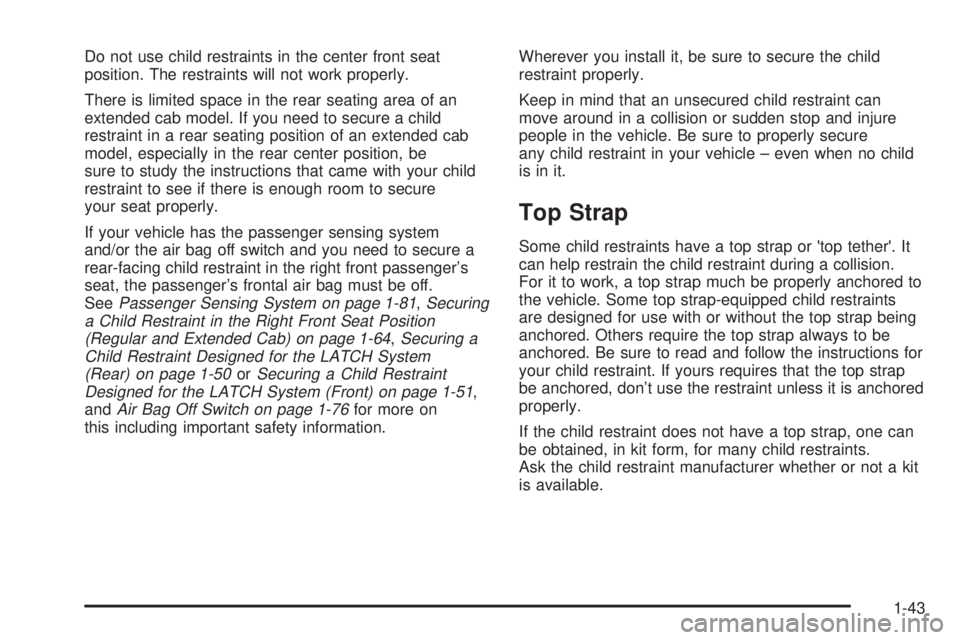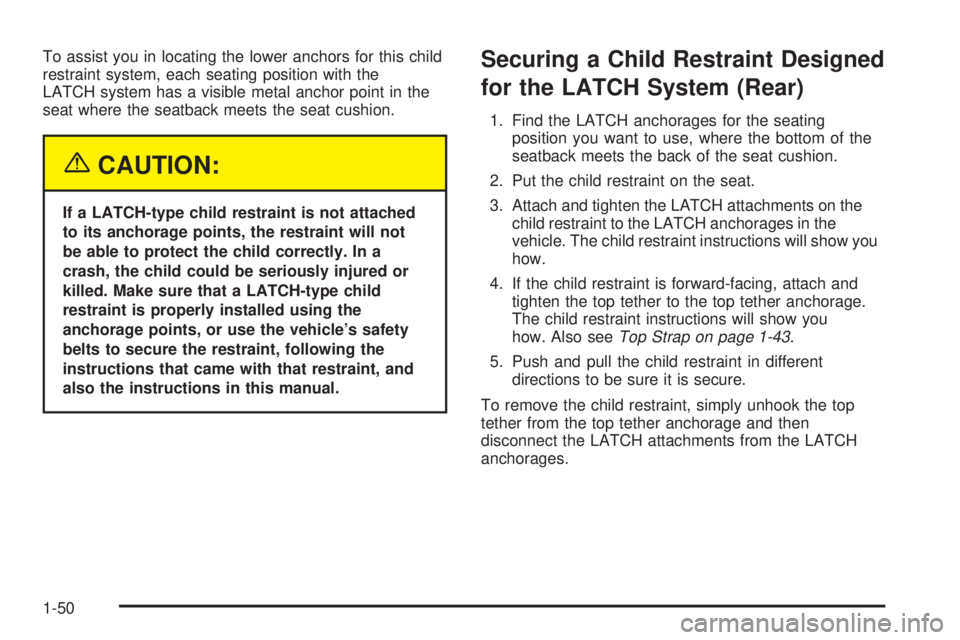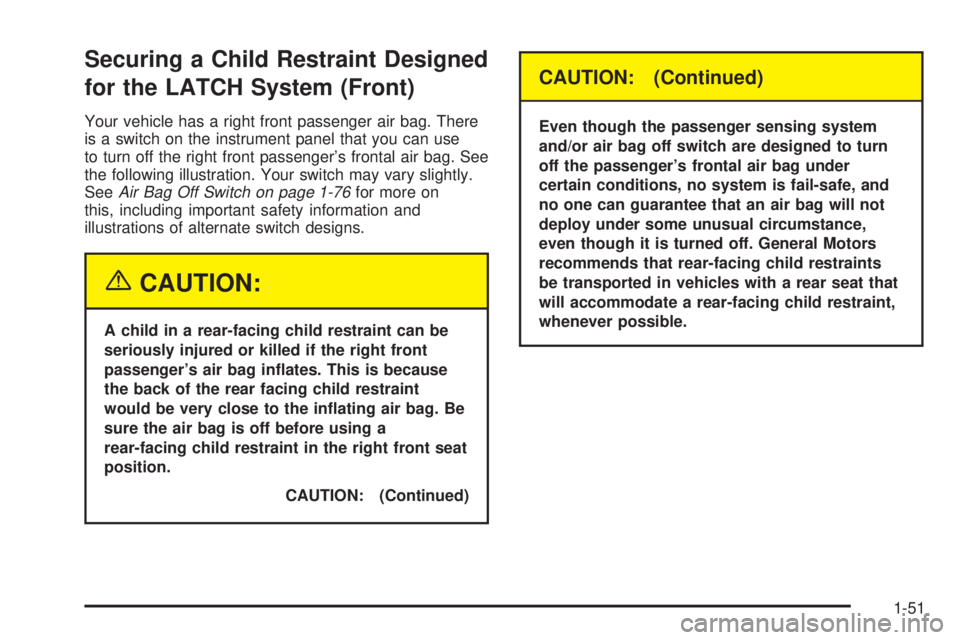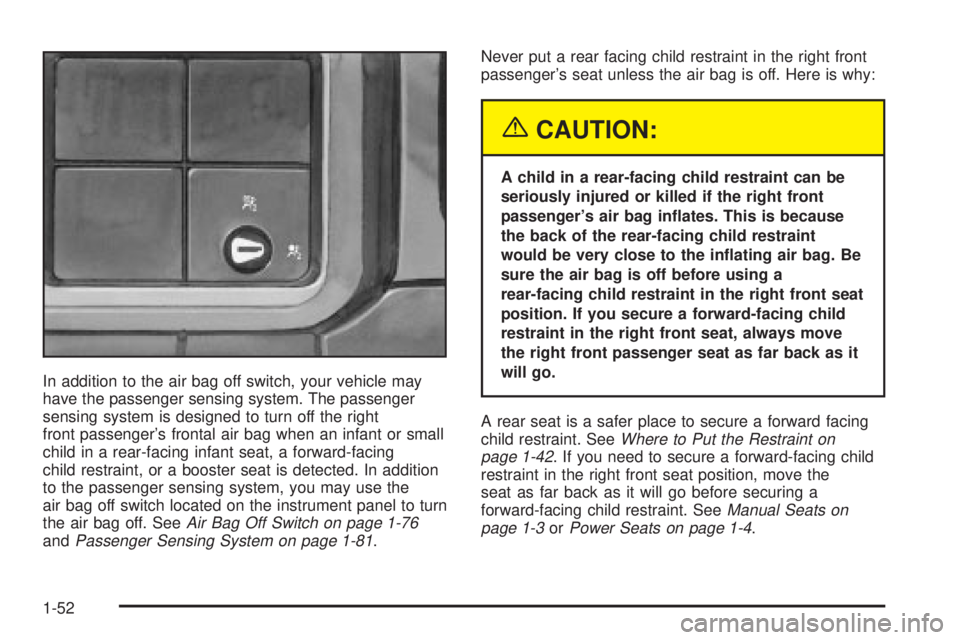Page 48 of 588

Where to Put the Restraint
Accident statistics show that children are safer if they
are restrained in the rear rather than the front seat.
General Motors recommends that child restraints
be secured in a rear seat including an infant riding in a
rear-facing infant seat, a child riding in a forward-facing
child seat and an older child riding in a booster seat.
Never put a child in a rear-facing child restraint in
the right front passenger seat unless your vehicle has
the passenger sensing system and/or an air bag
off switch and the air bag status indicator shows off.
Never put a rear facing child restraint in the right front
passenger seat unless the air bag is off. Here is why:
{CAUTION:
A child in a rear-facing child restraint can be
seriously injured or killed if the right front
passenger's air bag in¯ates. This is because the
back of the rear-facing child restraint would be
very close to the in¯ating air bag. Be sure the air
bag is off before using a rear-facing child
restraint in the right front seat position.
CAUTION: (Continued)
CAUTION: (Continued)
Even though the passenger sensing system
and/or air bag off switch are designed to turn
off the passenger's frontal air bag under
certain conditions, no system is fail-safe, and
no one can guarantee that an air bag will not
deploy under some unusual circumstance,
even though it is turned off. General Motors
recommends that rear-facing child restraints
be transported in vehicles with a rear seat that
will accommodate a rear-facing child restraint,
whenever possible.
If you secure a forward-facing child restraint in
the right front seat, always move the front
passenger seat as far back as it will go. It is
better to secure the child restraint in a rear seat.
1-42
Page 49 of 588

Do not use child restraints in the center front seat
position. The restraints will not work properly.
There is limited space in the rear seating area of an
extended cab model. If you need to secure a child
restraint in a rear seating position of an extended cab
model, especially in the rear center position, be
sure to study the instructions that came with your child
restraint to see if there is enough room to secure
your seat properly.
If your vehicle has the passenger sensing system
and/or the air bag off switch and you need to secure a
rear-facing child restraint in the right front passenger's
seat, the passenger's frontal air bag must be off.
See
Passenger Sensing System on page 1-81,Securing
a Child Restraint in the Right Front Seat Position
(Regular and Extended Cab) on page 1-64
,Securing a
Child Restraint Designed for the LATCH System
(Rear) on page 1-50
orSecuring a Child Restraint
Designed for the LATCH System (Front) on page 1-51,
andAir Bag Off Switch on page 1-76for more on
this including important safety information.Wherever you install it, be sure to secure the child
restraint properly.
Keep in mind that an unsecured child restraint can
move around in a collision or sudden stop and injure
people in the vehicle. Be sure to properly secure
any child restraint in your vehicle ± even when no child
is in it.
Top Strap
Some child restraints have a top strap or ©top tether©. It
can help restrain the child restraint during a collision.
For it to work, a top strap much be properly anchored to
the vehicle. Some top strap-equipped child restraints
are designed for use with or without the top strap being
anchored. Others require the top strap always to be
anchored. Be sure to read and follow the instructions for
your child restraint. If yours requires that the top strap
be anchored, don't use the restraint unless it is anchored
properly.
If the child restraint does not have a top strap, one can
be obtained, in kit form, for many child restraints.
Ask the child restraint manufacturer whether or not a kit
is available.
1-43
Page 52 of 588
Once you have the top strap anchored, you'll be ready to
secure the child restraint itself. Tighten the top strap
when and as the child restraint manufacturer's
instructions say.
Rear Seat Top Strap Anchors
(Extended Cab Models)
If your vehicle is an extended cab model, you'll ®nd the
top strap anchors for the rear seating positions near
the top of the seatback. In addition to the top strapanchors, each seating position has a fabric loop at the
top of the seatback that you'll use to route a top
strap through.
When using a child restraint with a top strap in either
rear outboard position, raise the head restraint and route
the top strap through the fabric loop on the seatback.
Then, attach the top strap to the anchor point at
the center rear seating position.
1-46
Page 53 of 588
When using a child restraint with a top strap in the
center rear position, route the top strap through
the fabric loop on the seatback. Then, raise the head
restraint and attach the top strap to the anchor
point located at the closest outboard position.
Once you have the top strap anchored, you'll be ready
to secure the child restrain itself. Tighten the top
strap when and as the child restraint manufacturer's
instructions say.
Rear Seat Top Strap Anchors
(Crew Cab Models)
If your vehicle is a Crew Cab model, you'll ®nd top strap
anchors for the rear seating positions located on the
back panel of your vehicle, behind the rear seat.
1-47
Page 54 of 588
In order to get to the brackets, you'll have to remove the
trim plugs covering them.
There are also anchorage points at the rear base of the
front passenger's seat.
Lower Anchorages and Top Tethers
for Children (LATCH System)
Your vehicle has the LATCH system. You will ®nd
anchors (A) for the front passenger and the center rear
seating positions for extended cab models. For
regular cab models, you will ®nd anchors for the right
front passenger seating position. For crew cab models,
you will ®nd anchors for the second row center and
second row right passenger seating positions.
This system, designed to make installation of child
restraints easier, does not use the vehicle's safety belts.
Instead, it uses vehicle anchors (A, B) and child
restraint attachments to secure the restraints. Some
restraints also use another vehicle anchor to secure a
top tether strap (C).
1-48
Page 56 of 588

To assist you in locating the lower anchors for this child
restraint system, each seating position with the
LATCH system has a visible metal anchor point in the
seat where the seatback meets the seat cushion.
{CAUTION:
If a LATCH-type child restraint is not attached
to its anchorage points, the restraint will not
be able to protect the child correctly. In a
crash, the child could be seriously injured or
killed. Make sure that a LATCH-type child
restraint is properly installed using the
anchorage points, or use the vehicle's safety
belts to secure the restraint, following the
instructions that came with that restraint, and
also the instructions in this manual.
Securing a Child Restraint Designed
for the LATCH System (Rear)
1. Find the LATCH anchorages for the seating
position you want to use, where the bottom of the
seatback meets the back of the seat cushion.
2. Put the child restraint on the seat.
3. Attach and tighten the LATCH attachments on the
child restraint to the LATCH anchorages in the
vehicle. The child restraint instructions will show you
how.
4. If the child restraint is forward-facing, attach and
tighten the top tether to the top tether anchorage.
The child restraint instructions will show you
how. Also see
Top Strap on page 1-43.
5. Push and pull the child restraint in different
directions to be sure it is secure.
To remove the child restraint, simply unhook the top
tether from the top tether anchorage and then
disconnect the LATCH attachments from the LATCH
anchorages.
1-50
Page 57 of 588

Securing a Child Restraint Designed
for the LATCH System (Front)
Your vehicle has a right front passenger air bag. There
is a switch on the instrument panel that you can use
to turn off the right front passenger's frontal air bag. See
the following illustration. Your switch may vary slightly.
See
Air Bag Off Switch on page 1-76for more on
this, including important safety information and
illustrations of alternate switch designs.
{CAUTION:
A child in a rear-facing child restraint can be
seriously injured or killed if the right front
passenger's air bag in¯ates. This is because
the back of the rear facing child restraint
would be very close to the in¯ating air bag. Be
sure the air bag is off before using a
rear-facing child restraint in the right front seat
position.
CAUTION: (Continued)
CAUTION: (Continued)
Even though the passenger sensing system
and/or air bag off switch are designed to turn
off the passenger's frontal air bag under
certain conditions, no system is fail-safe, and
no one can guarantee that an air bag will not
deploy under some unusual circumstance,
even though it is turned off. General Motors
recommends that rear-facing child restraints
be transported in vehicles with a rear seat that
will accommodate a rear-facing child restraint,
whenever possible.
1-51
Page 58 of 588

In addition to the air bag off switch, your vehicle may
have the passenger sensing system. The passenger
sensing system is designed to turn off the right
front passenger's frontal air bag when an infant or small
child in a rear-facing infant seat, a forward-facing
child restraint, or a booster seat is detected. In addition
to the passenger sensing system, you may use the
air bag off switch located on the instrument panel to turn
the air bag off. See
Air Bag Off Switch on page 1-76andPassenger Sensing System on page 1-81.Never put a rear facing child restraint in the right front
passenger's seat unless the air bag is off. Here is why:
{CAUTION:
A child in a rear-facing child restraint can be
seriously injured or killed if the right front
passenger's air bag in¯ates. This is because
the back of the rear-facing child restraint
would be very close to the in¯ating air bag. Be
sure the air bag is off before using a
rear-facing child restraint in the right front seat
position. If you secure a forward-facing child
restraint in the right front seat, always move
the right front passenger seat as far back as it
will go.
A rear seat is a safer place to secure a forward facing
child restraint. See
Where to Put the Restraint on
page 1-42. If you need to secure a forward-facing child
restraint in the right front seat position, move the
seat as far back as it will go before securing a
forward-facing child restraint. See
Manual Seats on
page 1-3orPower Seats on page 1-4.
1-52